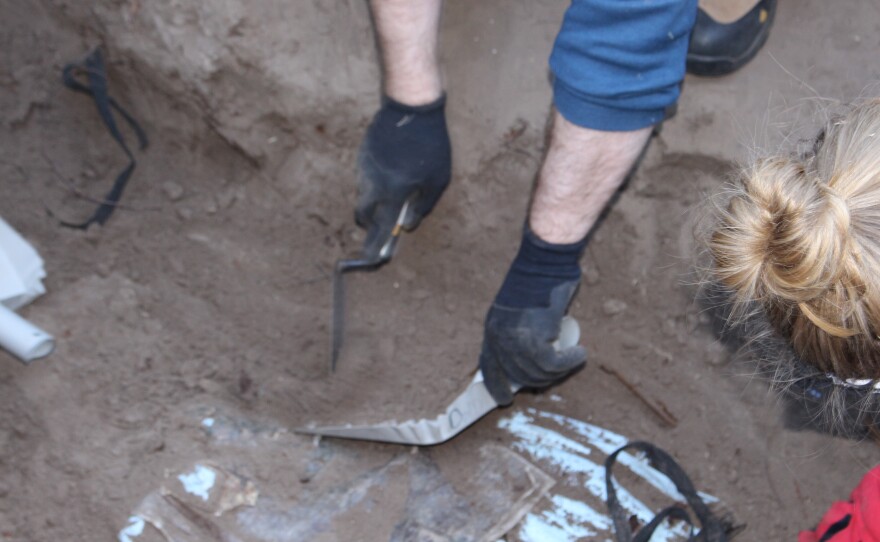It's estimated that in the last 10 years about 700 migrants died crossing the desert in Brooks County. This is ground zero of a South Texas humanitarian crisis where migrants risk death in order to enter the U.S. without legal authorization. What happens to the human remains of those who don’t make it? There is an effort to identify those bodies and reunite the remains with families.
On a bright winter’s day, workers dig into two graves at the Sacred Heart Cemetery in Falfurrias. This is a dig to retrieve bodies of unidentified migrants who died in the Brooks County desert.
“These are people that probably died on somebody's private ranch in Brooks County,” said Kate Spradley, a forensic anthropologist at Texas State University and director of Operation ID, which seeks to document and identify migrants' remains that are found in South Texas and then return those remains to their families.
“They're in the Texas desert walking to try to get around the checkpoint, and it's very easy to get disoriented," she said. "There's nothing to orient you north, so you can just walk around in the same mile for days not knowing which way north is. And when you get dehydrated or you're injured and you get separated from your group. … ”
Some of those human remains are discovered and end up buried here at Sacred Heart Cemetery. But they are buried without ceremony. It’s more accurate to say these human remains were disposed of by throwing them, without much care, into holes in the ground. The migrants’ bodies are sometimes in garbage bags, cardboard boxes or milk crates. Sometimes there are two, three or four individuals to a hole.

“A local informant came to us in January and told us that she could not buy the plot next to her father because there might be unidentified people buried there,” Spradley said.
Operation ID usually works like that; there are few records of unidentified migrant burials. South Texas counties are overwhelmed and underfunded for the task. That means when Spradley gets a tip that there might be some migrants buried in a spot, they go check it out. But, she says the people who oversee the Sacred Heart Cemetery aren’t much help.
“There's been maybe 130 that have been exhumed from this cemetery," she said. "There could be 50 more, there could be 100 more just in this cemetery alone. And this is the cemetery where the migrants are buried. We're in Brooks County. This is the county cemetery. So, this is where they go.”
This is where almost everyone in Brooks County gets buried. It’s a focal point of the community. Most of the gravestones are festooned with decorations to mark the passing holidays. There’s an active Facebook page for the cemetery with lots of festive graveside photos. The placement of the burial plots also tells the history of local racial segregation.
Community members are a little uneasy seeing how outsiders are digging up migrants, right in the middle of Sacred Heart.
“I was coming to visit my parents' grave, and I had to come see what was happening,” said San Juanita Olivares, who is a Falfurrias native. She was curious about the activity in the cemetery.
“I'm glad they're finding out. I'm glad they're finding these bodies, especially the unidentified ones. I think if I had a son or daughter who was missing, I'd want to know. After this part, they hopefully will be identified,” she said.
It’s taken a full day of digging, and the team of forensic anthropology students have been shoveling dirt, hauling it away on wheelbarrows and then using hand spades and brushes. They have uncovered evidence of other possible burials at this site but mainly they have exposed one burial. It’s an individual in a blue cremation bag.
The team is going to carefully hoist the stiff remains out of the grave and place it into a white plastic disaster body bag.
And now the real work begins that might lead to matching a name to the body.
“We'll submit a DNA sample to the federal DNA database called CODIS, the combined DNA index system. We'll put all of the information we have about this person into and to NamUs, which is the national and unidentified missing persons system. And NamUs is nice because we upload that information, we upload photos of any personal effects, clothing. Sometimes there are religious prayer cards, sometimes stuffed animals, Luchador mask," Spradley explained.
Anyone can search the NamUs website. Families go online looking for answers about what happened to their missing loved ones.
“We've identified 35 people so far, and we have a few more identifications pending. And you know, it's great to make an identification, but for that family member, we have to realize that it's the first time they have to process the death. You know, it's not the outcome that they had hoped for, but they get answers to questions and I think that helps them quite a bit. They don't have to not know anymore,” she said.
The Brooks County Sheriff’s Department estimates that for every migrant body recovered there are five others that were left out in the desert and were never recovered. Their remains were set upon by the varmints and the elements. They essentially became part of the landscape, which is why many people look at South Texas and say the entire area is now one big graveyard.
David Martin Davies can be reached at DMDavies@TPR.org and on Twitter at @DavidMartinDavi.









